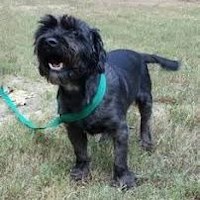Appearance of the Bascottie
|
| The Bascottie is a small to medium-sized hybrid between the Basset Hound and the Scottish Terrier. Your Bascottie will develop Scottish Terrier-like characteristics with a wiry, generally black coat and can be difficult to distinguish from the Scottish Terrier breed. However, the ears are slightly larger and set lower on the head, and the nose is a little larger than Scottish Terriers. Scottish Terriers are low to the ground but in proportion to their body size, whereas the Basset Hound's stature is exaggerated. The Bascottie maintains the exaggerated look with sturdy legs and a slightly longer body than the Scottish Terrier. A Bascottie's tail is carried level with the back and can curve slightly, but it can also stand straight when the dog is excited, just like its Scottish Terrier relative. |
Temperament of the Bascottie
|
| Although not particularly suspicious of strangers, the Bascottie will size up newcomers and quickly form an opinion. Showing respect and remaining cheerful is the best way to approach a Bascottie, since Scottish Terriers are sensitive to human emotions. This hybrid is intelligent but can sometimes be slightly stubborn. The Basset Hound parent means the Bascottie can respond well to food-based reward training, but Scottish Terriers are better known for their independence and your Bascottie can do as he pleases. |
Needs and activities of the Bascottie
|
| The Bascottie has a high-energy temperament, like its Scottish Terrier relative, and is often serious. They can be vocal and opinionated when upset, but are not known for long barking. The Basset Hound parent adds a more homogenous character to the Bascottie, as well as a love of children and other animals. The Bascottie needs human companionship, but doesn't like to be teased or play rough games regardless of its agile nature, so older children who know how to interact with dogs are better suited to this hybrid. |
Maintenance of the Bascottie
|
| A Bascottie's double coat means that the longer hairs don't shed as often. Regular brushing will keep this hybrid looking and feeling good, and a variety of brushes should be used every week. Stiff brushes, dog gloves and wide-tooth combs are ideal grooming accessories you can use to keep the coat healthy. The Bascottie, although related to the drooling Basset Hound, is not known for drooling and its clean coat prevents it from developing doggy odors. Basset Hounds have large ears, but the Bascottie's ears are considerably smaller. Despite their small size, it's still a good idea to clean your Bascottie's ears with a vet-approved solution once a week to remove dirt, wax and debris. |









 English (United Kingdom)
English (United Kingdom)